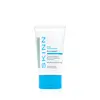What's inside
What's inside
 Key Ingredients
Key Ingredients

 Benefits
Benefits

 Concerns
Concerns

 Ingredients Side-by-side
Ingredients Side-by-side

Water
Skin ConditioningPumice
AbrasiveGlycerin
HumectantCaprylic/Capric Triglyceride
MaskingDimethicone
EmollientEthylhexyl Palmitate
EmollientCetyl Alcohol
EmollientStearyl Alcohol
EmollientTitanium Dioxide
Cosmetic ColorantCetearyl Alcohol
EmollientCeteareth-20
CleansingGlyceryl Stearate
EmollientPEG-100 Stearate
Saccharum Officinarum Extract
MoisturisingCitrus Medica Limonum Fruit Extract
Skin ConditioningPyrus Malus Fruit Extract
Skin ConditioningCamellia Sinensis Leaf Extract
AntimicrobialSodium Acrylate/Sodium Acryloyldimethyl Taurate Copolymer
Emulsion StabilisingIsohexadecane
EmollientPolysorbate 80
EmulsifyingSodium Benzoate
MaskingGluconolactone
Skin ConditioningXanthan Gum
EmulsifyingSodium Magnesium Silicate
Tetrasodium EDTA
Parfum
MaskingBlue 1 Lake
Cosmetic ColorantWater, Pumice, Glycerin, Caprylic/Capric Triglyceride, Dimethicone, Ethylhexyl Palmitate, Cetyl Alcohol, Stearyl Alcohol, Titanium Dioxide, Cetearyl Alcohol, Ceteareth-20, Glyceryl Stearate, PEG-100 Stearate, Saccharum Officinarum Extract, Citrus Medica Limonum Fruit Extract, Pyrus Malus Fruit Extract, Camellia Sinensis Leaf Extract, Sodium Acrylate/Sodium Acryloyldimethyl Taurate Copolymer, Isohexadecane, Polysorbate 80, Sodium Benzoate, Gluconolactone, Xanthan Gum, Sodium Magnesium Silicate, Tetrasodium EDTA, Parfum, Blue 1 Lake
Caprylic/Capric Triglyceride
MaskingMagnesium Oxide
AbsorbentGlycerin
HumectantOleth-20
CleansingGlyceryl Stearate
EmollientSodium Bicarbonate
AbrasiveZeolite
AbsorbentPolylactic Acid
AbrasiveTrihydroxystearin
Skin ConditioningWater
Skin ConditioningMentha Piperita Oil
MaskingOlea Europaea Fruit Oil
MaskingPrunus Amygdalus Dulcis Oil
Skin ConditioningSqualane
EmollientMenthol
MaskingRosmarinus Officinalis Leaf Oil
MaskingTocopheryl Acetate
AntioxidantTetrahexyldecyl Ascorbate
AntioxidantMagnesium Ascorbyl Phosphate
AntioxidantSodium Ascorbyl Phosphate
Antioxidant3-O-Ethyl Ascorbic Acid
Skin ConditioningAscorbyl Glucoside
AntioxidantAscorbic Acid
AntioxidantAscorbyl Palmitate
AntioxidantZinc Oxide
Cosmetic ColorantAnthemis Nobilis Flower Oil
MaskingPapain
Skin ConditioningBromelain
Skin ConditioningMelaleuca Alternifolia Leaf Oil
AntioxidantLavandula Angustifolia Oil
MaskingCopper PCA
HumectantDimethicone
EmollientCocamidopropyl Betaine
CleansingSodium Chloride
MaskingAlcohol Denat.
AntimicrobialTerminalia Ferdinandiana Fruit Extract
AntioxidantOryza Sativa Bran Cera
Skin ConditioningLimonene
PerfumingCI 77289
Cosmetic ColorantCI 42090
Cosmetic ColorantPhenoxyethanol
PreservativeEthylhexylglycerin
Skin ConditioningCaprylic/Capric Triglyceride, Magnesium Oxide, Glycerin, Oleth-20, Glyceryl Stearate, Sodium Bicarbonate, Zeolite, Polylactic Acid, Trihydroxystearin, Water, Mentha Piperita Oil, Olea Europaea Fruit Oil, Prunus Amygdalus Dulcis Oil, Squalane, Menthol, Rosmarinus Officinalis Leaf Oil, Tocopheryl Acetate, Tetrahexyldecyl Ascorbate, Magnesium Ascorbyl Phosphate, Sodium Ascorbyl Phosphate, 3-O-Ethyl Ascorbic Acid, Ascorbyl Glucoside, Ascorbic Acid, Ascorbyl Palmitate, Zinc Oxide, Anthemis Nobilis Flower Oil, Papain, Bromelain, Melaleuca Alternifolia Leaf Oil, Lavandula Angustifolia Oil, Copper PCA, Dimethicone, Cocamidopropyl Betaine, Sodium Chloride, Alcohol Denat., Terminalia Ferdinandiana Fruit Extract, Oryza Sativa Bran Cera, Limonene, CI 77289, CI 42090, Phenoxyethanol, Ethylhexylglycerin
Ingredients Explained
These ingredients are found in both products.
Ingredients higher up in an ingredient list are typically present in a larger amount.
This ingredient is an emollient, solvent, and texture enhancer. It is considered a skin-softener by helping the skin prevent moisture loss.
It helps thicken a product's formula and makes it easier to spread by dissolving clumping compounds.
Caprylic Triglyceride is made by combining glycerin with coconut oil, forming a clear liquid.
While there is an assumption Caprylic Triglyceride can clog pores due to it being derived from coconut oil, there is no research supporting this.
Learn more about Caprylic/Capric TriglycerideDimethicone is a type of synthetic silicone created from natural materials such as quartz.
What it does:
Dimethicone comes in different viscosities:
Depending on the viscosity, dimethicone has different properties.
Ingredients lists don't always show which type is used, so we recommend reaching out to the brand if you have questions about the viscosity.
This ingredient is unlikely to cause irritation because it does not get absorbed into skin. However, people with silicone allergies should be careful about using this ingredient.
Note: Dimethicone may contribute to pilling. This is because it is not oil or water soluble, so pilling may occur when layered with products. When mixed with heavy oils in a formula, the outcome is also quite greasy.
Learn more about DimethiconeGlycerin is already naturally found in your skin. It helps moisturize and protect your skin.
A study from 2016 found glycerin to be more effective as a humectant than AHAs and hyaluronic acid.
As a humectant, it helps the skin stay hydrated by pulling moisture to your skin. The low molecular weight of glycerin allows it to pull moisture into the deeper layers of your skin.
Hydrated skin improves your skin barrier; Your skin barrier helps protect against irritants and bacteria.
Glycerin has also been found to have antimicrobial and antiviral properties. Due to these properties, glycerin is often used in wound and burn treatments.
In cosmetics, glycerin is usually derived from plants such as soybean or palm. However, it can also be sourced from animals, such as tallow or animal fat.
This ingredient is organic, colorless, odorless, and non-toxic.
Glycerin is the name for this ingredient in American English. British English uses Glycerol/Glycerine.
Learn more about GlycerinGlyceryl Stearate is a mix of glycerin and stearic acid.
It is used to stabilize the mixing of water and oil ingredients. By preventing these ingredients from separating, it can help elongate shelf life. It can also help thicken the product's texture.
As an emollient, it helps soften skin and supports barrier-replenishing ingredients.
In cosmetics, Glyceryl Stearate is often made from vegetable oils or synthetically produced.
This ingredient may not be fungal-acne safe
Fun fact: The human body also creates Glyceryl Stearate naturally.
Learn more about Glyceryl StearateWater. It's the most common cosmetic ingredient of all. You'll usually see it at the top of ingredient lists, meaning that it makes up the largest part of the product.
So why is it so popular? Water most often acts as a solvent - this means that it helps dissolve other ingredients into the formulation.
You'll also recognize water as that liquid we all need to stay alive. If you see this, drink a glass of water. Stay hydrated!
Learn more about Water